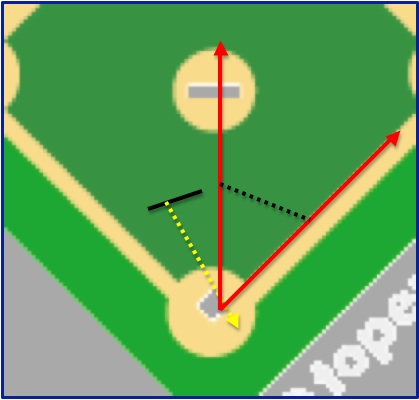Slider Drill
June 28, 2012 by Coach McCreary
Filed under Hitting
One of the problems older players run into is that more pitchers they face will throw better breaking pitches. But how does a hitter practice hitting a breaking pitch? If your father, brother, mom, teammate, or coach has an ok curve or slider, he/she could always throw some. However, that is unlikely to be the case. On top of that, nobody will be able to (or want to) snap off 50 sliders in a row just so you can practice hitting it. If they did, they may soon be ordering a new elbow. So, is it possible to practice hitting breaking pitches without a pitching machine? Yes, and here’s an example of how it can be done.
The diagram shows a drill for sliders that can be done as a soft-toss drill (underhand toss from a short distance away), a short-toss drill (overhand toss from about 10-15 feet away), or a more full length throw similar to batting practice. The short solid black line represents an L-screen that someone would stand/sit behind for protection. The dotted yellow line represents the throw. You’ll notice that because the L-screen is positioned on the 3rd base side of the field that the throw is approaching the plate on an angle. This mimics the later movement of a slider that would break away from a right handed batter (in towards a lefty). The two red lines represent where the batter (righty) should hit the ball during this drill – the right side of the field. This forces the batter to wait for the slider instead of jumping at it and/or “rolling it over” and producing a weak grounder to shortstop. His goal should be low line drives and hard ground balls.
Some other tips for this drill:
- A slider is usually a higher velocity pitch so the guy throwing it should underhand it, short toss it, or throw it firmly. The shorter distance of the throw helps with this.
- Make sure the batter continues to set-up and stride like they would if the ball was coming from the mound. With this drill, some batters will tend to open up and/or stride towards the L-screen and hit the ball to the left side of the field. This defeats the purpose of the drill. Everything the batter does is the same as always. What changes is simply the angle of the ball coming in.
- Although I’ve seen this drill done without an L-screen (the ball is hit to the right side and away from the thrower), please use some kind of a screen for safety. All it takes is one swing that is too early or a stride that goes towards the thrower for a line drive to come right back at the thrower. Obviously, that could ruin your day in a hurry.
- If you are the thrower and have a weak arm, don’t be afraid to get very close to the batter with the screen. Underhanding it across the plate is fine and as the diagram shows, the ball should not be hit your way anyway.
- If you position the L-screen on the first base side of the field, you can mimic a slider thrown by a left handed pitcher.
- This drill is also great for left handed hitters who need practice hitting off left handed pitchers. It helps the batter keep his front side closed longer. Position the screen on the first base side for this variation.
Tomorrow’s post I’ll present a couple drills designed to help with hitting curveballs.






Leave a Reply